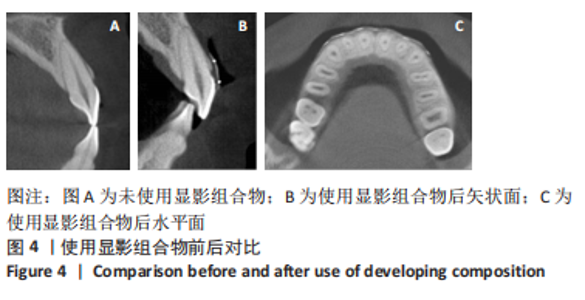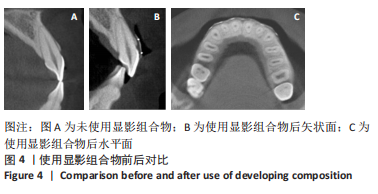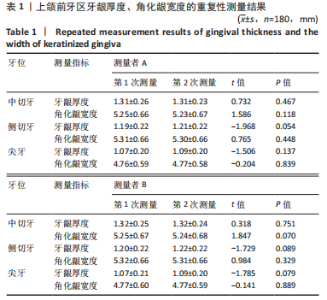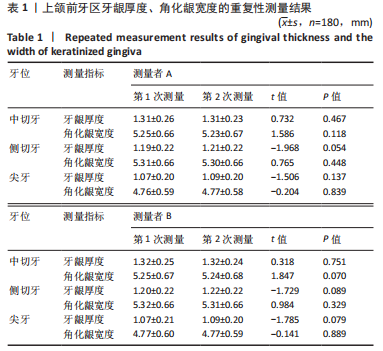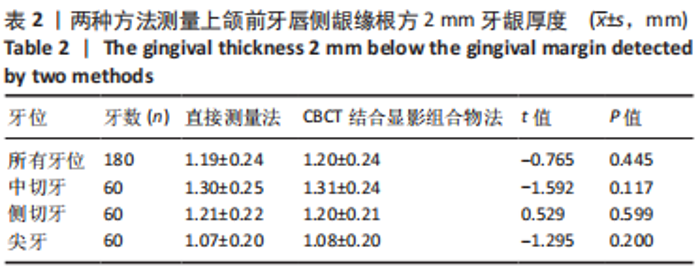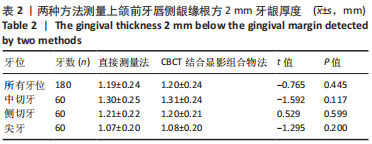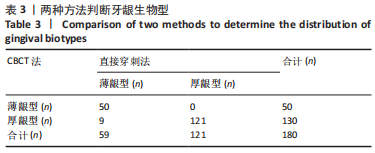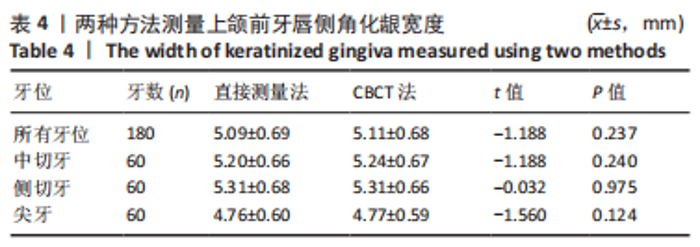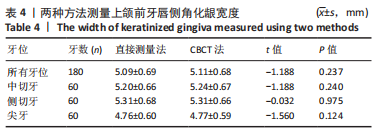[1] ZWEERS J, THOMAS RZ, SLOT DE, et al. Characteristics of periodontal biotype, its dimensions, associations and prevalence: a systematic review. J Clin Periodontol. 2014;41(10):958-971.
[2] KARAKıŞ AKCAN S, GÜLER B, et al. The effect of different gingival phenotypes on dimensional stability of free gingival graft: A comparative 6‐month clinical study. J Periodontol. 2019;90(7):709-717.
[3] KLOUKOS D, KALIMERI E, KOUKOS G, et al. Gingival thickness threshold and probe visibility through soft tissue: a cross-sectional study. Clin Oral Investig. 2022; 26(8):5155-5161.
[4] 闫雪丹, 张丽娜, 任秀云. 前牙区牙龈生物型研究进展[J]. 口腔医学研究, 2019,35(2):116-118.
[5] BOYNUEĞRI D, NEMLI SK, KASKO YA. Significance of keratinized mucosa around dental implants: a prospective comparative study. Clin Oral Implan Res. 2013; 24(8): 928-933.
[6] 邹新明. 基于锥形束CT的上颌前牙区牙周生物型的研究[D]. 广州:暨南大学,2018.
[7] 束蓉. 牙周生物型对口腔多学科治疗的影响[J]. 中华口腔医学杂志,2014, 49(3):129-132.
[8] SHAFIZADEH M, AMID R, TEHRANCHI A, et al. Evaluation of the association between gingival phenotype and alveolar bone thickness: A systematic review and meta-analysis. Arch Oral Biol. 2022;133:105287.
[9] BALDI C, PINI‐PRATO G, PAGLIARO U, et al. Coronally advanced flap procedure for root coverage. Is flap thickness a relevant predictor to achieve root coverage? A 19‐case series. J Periodontol. 1999;70(9):1077-1084.
[10] MANJUNATH RS, RANA A, SARKAR A. Gingival biotype assessment in a healthy periodontium: transgingival probing method. J Clin Diagn Res. 2015;9(5):ZC66-69.
[11] GÁNTI B, BEDNARZ W, KŐMŰVES K, et al. Reproducibility of the PIROP ultrasonic biometer for gingival thickness measurements. J Esthet Restor Dent. 2019;31(3): 263-267.
[12] 乐迪, 张豪, 胡文杰, 等. 牙周探诊法判断牙龈生物型的初步研究[J].中华口腔医学杂志,2012,47(2): 81-84.
[13] Fu JH, Yeh CY, Chan HL, et al. Tissue biotype and its relation to the underlying bone morphology. J Periodontol. 2010;81(4):569-574.
[14] JANUARIO AL, BARRIVIERA M, DUARTE WR. Soft tissue cone‐beam computed tomography: A novel method for the measurement of gingival tissue and the dimensions of the dentogingival unit. J Esthet Restor Dent. 2008;20(6):366-373.
[15] AMID R, MIRAKHORI M, SAFI Y, et al. Assessment of gingival biotype and facial hard/soft tissue dimensions in the maxillary anterior teeth region using cone beam computed tomography. Arch Oral Biol. 2017;79:1-6.
[16] KAMINAKA A, NAKANO T, ONO S, et al. Cone‐beam computed tomography evaluation of horizontal and vertical dimensional changes in buccal peri‐implant alveolar bone and soft tissue: a 1‐year prospective clinical study. Clin Implant Dent Relat Res. 2015;17 Suppl 2:e576-585.
[17] KAN J, MORIMOTO T, RUNGCHARASSAENG K, et al. Gingival biotype assessment in the esthetic zone: visual versus direct measurement. Int J Periodontics Restorative Dent. 2010;30(3):237-243.
[18] 朱娟芳,田雪丽,田丽萍,等.下颌前牙唇舌侧骨壁厚度的锥形束CT研究[J].实用放射学杂志,2016,32(8):1190-1193.
[19] AHMAD M, JENNY J, DOWNIE M. Application of cone beam computed tomography in oral and maxillofacial surgery. Aust Dent J. 2012;57:82-94.
[20] CARTER JB, STONE JD, CLARK RS, et al. Applications of cone-beam computed tomography in oral and maxillofacial surgery: an overview of published indications and clinical usage in United States academic centers and oral and maxillofacial surgery practices. J Oral Maxil Surg.2016;74(4):668-679.
[21] VENKATESH E, ELLURU SV. Cone beam computed tomography: basics and applications in dentistry.J Istanb Univ Fac Dent. 2017;51(3 Suppl 1):S102-S121.
[22] 曹洁, 胡文杰, 张豪, 等. 基于锥形束计算机体层摄影术测量牙龈厚度[J]. 北京大学学报 (医学版),2013,45(1):135-139.
[23] NEWBY EE, BORDAS A, KLEBER C, et al. Quantification of gingival contour and volume from digital impressions as a novel method for assessing gingival health. Int Dent J. 2011;61 Suppl 3(Suppl 3):4-12.
[24] MARTI AM, HARRIS BT, METZ MJ, et al.Comparison of digital scanning and polyvinyl siloxane impression techniques by dental students: instructional efficiency and attitudes towards technology. Eur J Dent Educ. 2017;21(3):200-205.
[25] 张薇, 安维康, 洪涛, 等. 上颌前牙牙龈厚度与牙槽骨厚度相关性的数字化测量分析[J]. 中华口腔医学杂志,2022,57(1): 85-90.
[26] 袁洁, 郭倩倩, 李麒,等. 上颌前牙区牙周生物型特征间的相关性研究[J]. 华西口腔医学杂志,2020,38(4):398-403.
[27] 张瑞, 束蓉. 采用锥形束CT测量汉族年轻人群前牙唇侧健康牙龈厚度[J]. 临床和实验医学杂志,2018,17(2):214-218.
[28] 龚寅, 谢玉峰, 束蓉. 上海汉族青年牙龈生物型的CBCT检测[J].上海交通大学学报(医学版),2017,37(8): 1111-1115.
[29] BORGES GJ, RUIZ LF, DE ALENCAR AH,et al. Cone-beam computed tomography as a diagnostic method for determination of gingival thickness and distance between gingival margin and bone crest. ScientificWorldJournal. 2015;2015:142108.
[30] 贾凯梦,孙晓军,李晶. 锥形束CT测量牙龈厚度准确性的初步研究[J]. 医学影像学杂志,2020,30(2):187-191.
[31] MARQUEZ IC. The role of keratinized tissue and attached gingiva in maintaining periodontal/peri-implant health. Gen Dent. 2004;52(1):74-8;quiz 79.
[32] MONJE A, BLASI G. Significance of keratinized mucosa/gingiva on peri‐implant and adjacent periodontal conditions in erratic maintenance compliers. J Periodontol. 2019;90(5):445-453.
[33] 张艳玲,张豪,胡文杰,等. 120名汉族青年前段牙弓唇侧角化龈宽度的测量[J]. 中华口腔医学杂志,2010,45(8):477-481.
|
